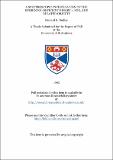Files in this item
A spectroscopic investigation of the hydro-deficient binary Upsilon Sgr, and related objects
Item metadata
| dc.contributor.advisor | Jeffery, C. Simon | |
| dc.contributor.author | Dudley, Richard E. | |
| dc.coverage.spatial | 343 p. | en_US |
| dc.date.accessioned | 2018-06-21T15:52:11Z | |
| dc.date.available | 2018-06-21T15:52:11Z | |
| dc.date.issued | 1992 | |
| dc.identifier.uri | https://hdl.handle.net/10023/14426 | |
| dc.description.abstract | The bright hydrogen-deficient binary Upsilon Sgr has been studied in detail in the areas of radial velocities, flux distribution, temperature, surface gravity, composition and mass loss using the analysis of spectroscopic data. From IUE high resolution spectra the primary radial velocity orbit has been confirmed (K₁ = 47.3±0.8kms⁻¹) and the secondary radial velocity curve determined for the first time (K₂ = 29.7±1.7kms⁻¹). The orbit has been constrained to an inclination of 65 - 78°. The masses of the primary and secondary are then 3.0 ± 0.3 and 4.8 ± 0.5M☉ respectively, with an orbital separation of 230±20R☉.The primary is expected to fill its Roche Lobe at a radius of ~60R☉.Using all the available photometry and line-blanketed hydrogen-deficient model atmospheres the primary effective temperature has been determined to be 11,800±500K. IUE spectra were used to determine an extinction of E[sub]B-v = 0.20±0.05 leading to a distance of ~1400pc and a luminosity of 61,000(+11,000)/(-5,000) L☉.. The long standing problem of the flux distribution has been mostly solved and little of the UV flux shortward of 1400 Å comes from a hot bright secondary. The same model atmospheres and a high resolution CCD/echelle spectrum was used to confirm the temperature (Teff= 11,750±750K) and to obtain a surface gravity of log g = 1.5±0.5. 𝜐 Sgr is ~ 99.6% helium, 0.016% H with CNO abundances indicative of advanced evolution and high main sequence mass. From profile fitting of the UV resonance lines of C, N and Si the mass-loss rate from 𝜐 Sgr is at least 2.5 x10⁻¹°M☉yr⁻¹. The upper limit to the mass-loss rate is 1.0 x10 ⁻⁵M☉yr⁻¹ from the lack of observed changes in the orbital parameters. The mass of the primary component and the low likely mass-loss rate indicate that the primary component will not be able to shed enough material before core collapse, an event that will be classed as a type Ib supernova. This is the first solid evidence that hydrogen-deficient binaries are progenitors of these objects although other candidates are not ruled out. The other known hydrogen-deficient binaries (KS Per, LSS 1922 and LSS 4300) have had their temperatures (12,500±500K, 12,000±500K, 12,000±1,000K) and interstellar extinctions (0.55± 0.05, 0.80±0.05, 0.90±0.10) re-determined from a flux distribution analysis. Mass-loss rates from 6 O stars, 3 Extreme Helium stars and 2 sdO stars have also been determined. The O and EHe results broadly agree with the previous determinations. Results for the 2 sdO stars, BD H-37° 1977 and BD +37 ° 442, are presented from profile fitting for the first time and indicate a mass-loss rate slightly higher than for the EHe stars. | en_US |
| dc.language.iso | en | en_US |
| dc.publisher | University of St Andrews | |
| dc.subject.lcc | QB903.D9 | |
| dc.subject.lcsh | Double stars | en |
| dc.title | A spectroscopic investigation of the hydro-deficient binary Upsilon Sgr, and related objects | en_US |
| dc.type | Thesis | en_US |
| dc.contributor.sponsor | United Kingdom. Ministry of Defence (R.A.R.D.E.) | en_US |
| dc.contributor.sponsor | Science and Engineering Research Council (SERC) | en_US |
| dc.type.qualificationlevel | Doctoral | en_US |
| dc.type.qualificationname | PhD Doctor of Philosophy | en_US |
| dc.publisher.institution | The University of St Andrews | en_US |
This item appears in the following Collection(s)
Items in the St Andrews Research Repository are protected by copyright, with all rights reserved, unless otherwise indicated.

